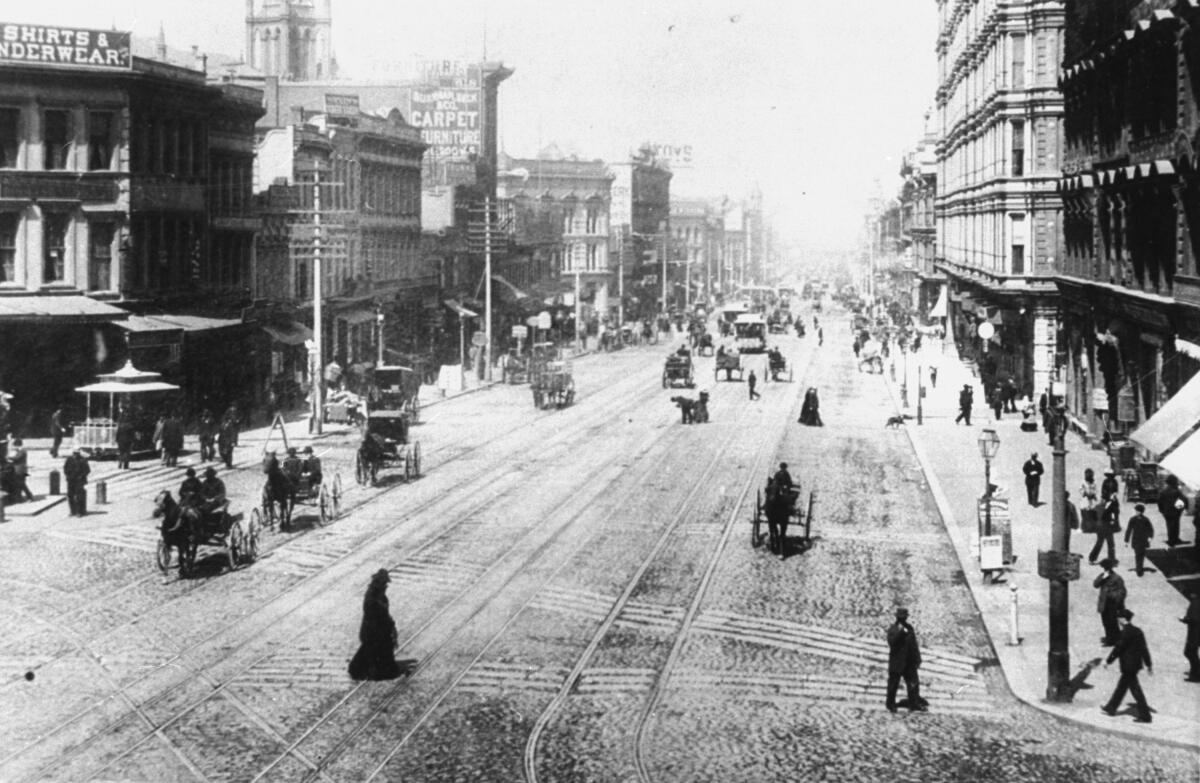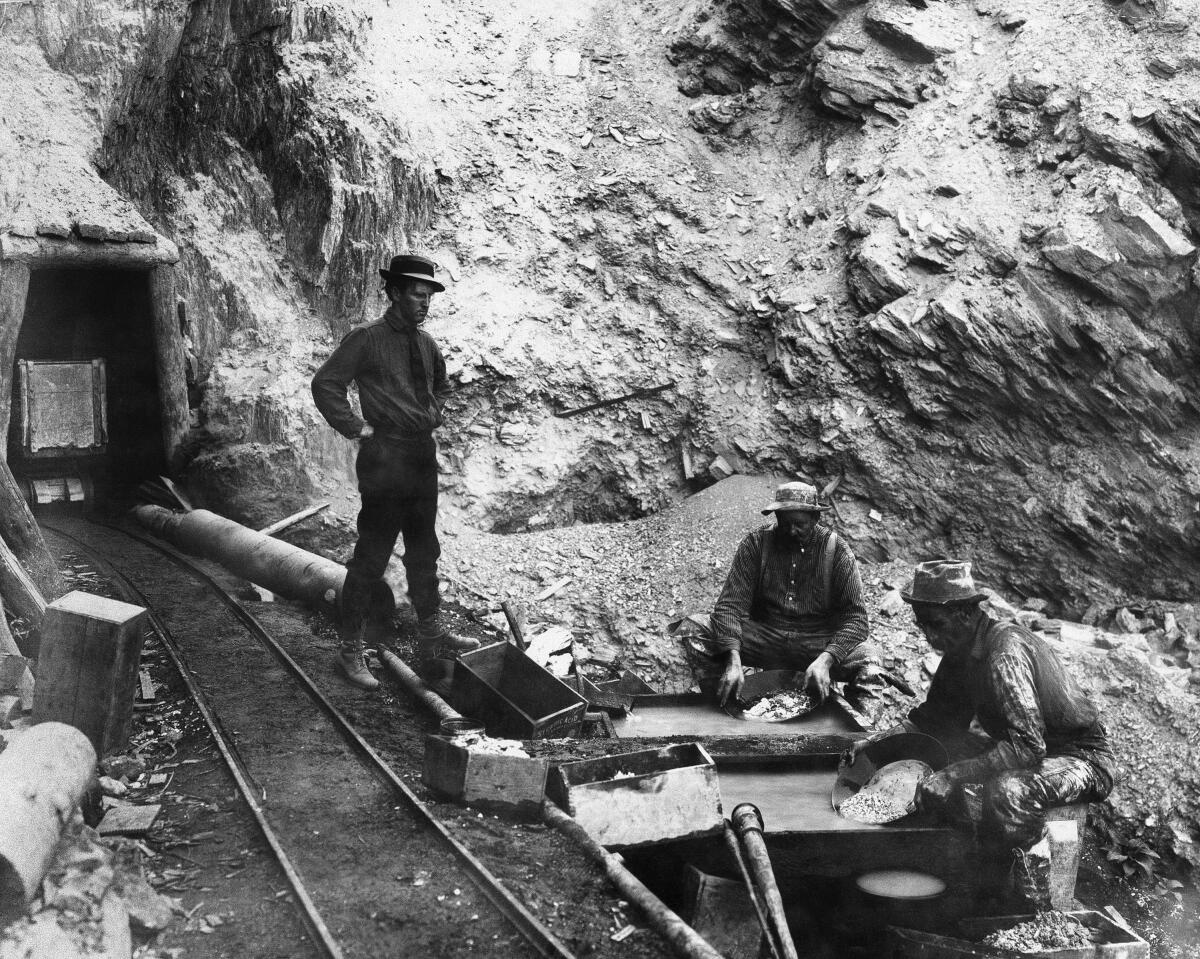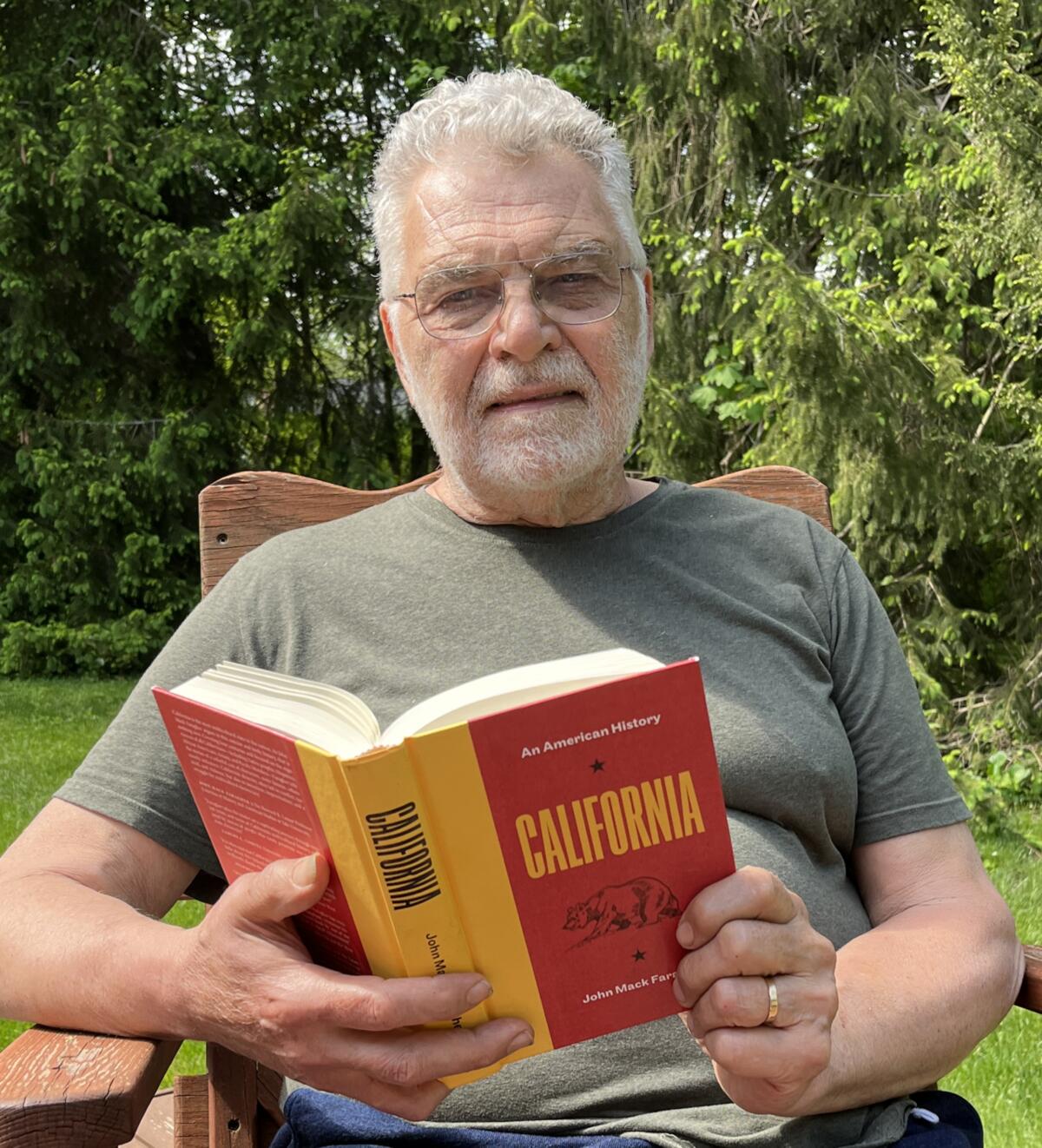Essential Politics: The one word that best describes California

As former L.A. Times’ reporter Evan Halper explained in his excellent “United States of California” series, you would be hard pressed to find another state that has influenced the nation more than the Golden one.
“No state has had a bigger impact on the direction of the United States than California, a prolific incubator and exporter of outside-the-box policies and ideas,” Evan wrote in introducing his stories.
So, how did California become America’s think tank?
Get our L.A. Times Politics newsletter
The latest news, analysis and insights from our politics team.
You may occasionally receive promotional content from the Los Angeles Times.
A great new book takes a stab at answering that question. John Mack Faragher, a retired Yale history professor, has just published “California: An American History,” which explores how the state became the most populous, diverse, economically dynamic and confounding state in the union. Kirkus calls the book “a masterful history of a place that is both reality and ideal, and central to the modern world.”
Welcome to to this week’s edition of Essential Politics. I’m Del Quentin Wilber, The Times’ White House editor, and I’m going to provide you some insights from Faragher. I’ll also catch up with Times reporter Noah Bierman before he heads to Asia to cover President Biden’s first big trip there.
The book on California
Here are some lightly edited excerpts of my recent interview with Faragher (oh, buy his book):
Can you sum up California in one word?
Diversity.
Geologic complexity produced a patchwork of local ecologies. The state’s Department of Fish and Wildlife lists 178 major habitats, more than any other state, populated by over 5,000 plant species and at least 1,000 animal species, many living no where else.
This natural abundance supplied the means for the growth of the largest Indigenous population of any region in the U.S. Native Californians lived in hundreds of communities of astounding cultural variety, speaking at least 78 distinct languages. Today the federal government recognizes 109 California bands and tribes, more than any other state.
Human diversity is the foundation of California history. The 22 adult men and women who founded the pueblo of Los Angeles included two Spaniards, two men of African descent, nine Mexican Indians, and nine individuals of mixed Spanish, African and Native ancestry
The gold rush drew men and women from every state in the union — Black and white, free and slave. Thousands more came from Mexico and elsewhere in Latin America, the Pacific Islands and Australia, China and Europe. A powerful migration from the Midwest began around the turn of the 20th century and extended into the 1920s, followed by a flood of displaced farm folk during the Depression.
With World War II, that tide became a tsunami. During the last two decades of the 20th century, powerful immigrant streams from Latin America and Asia brought millions more. Today, California’s 40 million residents make up the most diverse population of any state.
What made you want to write a 466-page book on the state? A return to your roots, having grown up in Southern California?
I went East to study the West, but California is in my blood. I have seven siblings as well as many nieces, nephews and extended relations in Southern California, and over the years I have remained close to family and friends.
I am a proud graduate of UC Riverside, where I got a world-class education. I spent several years in the archives of the Huntington Library and the Seaver Center for Western History Research at the Natural History Museum, researching a history of frontier Los Angeles. When offered the opportunity to write a history of the state, I grabbed it.

In your research, what period of California history most challenged your preconceived ideas of the state?
I grew up believing that California’s story began with the gold rush and that the boom just kept happening into my own time.
In fact, there was plenty of important history before the discovery of gold at Sutter’s Mill, and in the book I devote plenty of attention to it. But the real surprise for me was the long period of slow growth, even stagnancy, that followed the gold rush and preceded the turn-of-the-century boom. There was change, terrible change. The state declared genocidal war on Native communities, and the rights of Spanish-speaking citizens were ignored. Racism and anti-Asian nativism were the order of the day.
A major theme of your book is how the state was shaped by unrelenting waves of migration. Which of those waves most shaped the state we have today and why?
All of those waves had significant consequences, but I’d choose the one that began during World War II and extended into the 1950s, bringing more people over a shorter period of time than any other. Those migrants provided the labor for California’s industrial revolution, building on the economic base established in the 1920s, but focused largely on military production. A third of the migrants were African Americans, part of the “Great Migration” out of the South.
Mexicans, deported during the Depression, were brought back to work the fields. The Japanese were making a rough transition out of the internment camps. This was the beginning of modern California, with its suburban middle class aspirations and corresponding struggles by Blacks, Hispanics and Asians for ethnic and racial equality.
The state has a long history of whipsawing between political movements. How did a single state, in such a short time, produce such different leaders in governors Earl Warren and Ronald Reagan?
Warren left a positive legacy, Reagan a negative one. Warren became governor during the war, when the booming economy was generating enormous tax revenue for the state. Instead of lowering taxes, he created a huge “rainy day” fund for postwar conversion.
That became the hallmark of his tenure. As Warren put it, “Make no small plan for California.” He professionalized state government, funded public education, expanded higher education, began the freeway system and funded low-cost loans for home building. Republican Warren helped birth modern California. By the time Reagan was elected in 1966, however, the Republican Party had turned against Warren, who was then chief justice of the Supreme Court. In fiscal policy, education and housing, the state is still trying to recover from the retrenchment of Reagan and his movement.
What part of California history should be more thoroughly studied?
In 1850, California went directly from conquered territory to statehood, which put the state’s white citizens fully in charge of creating state government. They created a regime that refused to recognize the rights of former Mexican citizens and committed the state to the destruction of Native communities.
The Legislature refused to take up the ratification of the 14th Amendment, and rejected the 15th, which guaranteed the right of suffrage to all male American citizens. Among the “northern” states, California led the way to the politics of white supremacy, particularly the movement to restrict the rights of Chinese, Japanese and other Asian immigrants. This period of California history needs to be better known.

Our daily news podcast
If you’re a fan of this newsletter, you’ll love our daily podcast “The Times,” hosted every weekday by columnist Gustavo Arellano, along with reporters from across our newsroom. Go beyond the headlines. Download and listen on our App, subscribe on Apple Podcasts and follow on Spotify.
The presidential and vice presidential trips
I reached out to my colleague Noah Bierman, who covers the White House, to get some insights on Biden’s big trip to Asia and Vice President Kamala Harris’ recent sojourn to the United Arab Emirates.
When and where is Biden going and what is he hoping to accomplish on this trip to Asia?
Biden leaves on Friday and will go to South Korea and Japan. The main goal, as in a lot of these trips, is showing up. American leaders have promised for years that they would shift their foreign focus to Asia, but something almost always gets in the way. In this case, it was COVID, the withdrawal from Afghanistan and Russia’s invasion of Ukraine. It’s 16 months in, and Biden has yet to travel to Asia as president.
Biden wants to reassure Asian allies that the U.S. still cares and that it will help them shore up their strategic and economic defense against China, the strongest rival to the U.S. on the world stage.
Why did Harris go to UAE for a day? She spent more time in the air than on the ground, I think.
This was an unusual trip. She flew all the way there on Sunday afternoon, stayed on the ground for less than three hours on Monday and headed back to Washington. She met with Sheikh Mohammed bin Zayed Al Nahyan, the new president, and paid respects to his half-brother, Sheikh Khalifa bin Zayed Al Nahyan.
The UAE wields a lot of clout for such a small country. American reporters covering the quick trip bumped into two other delegations, including one from New Zealand, during the brief condolence call. French President Emmanuel Macron and British Prime Minister Boris Johnson showed up earlier in the day as did a parade of other leaders.
The biggest reason is oil. The U.S. and its allies want the UAE to pump more and help isolate Russia, with which it has close ties. But the UAE has said no, in part because its leaders are annoyed with Biden over a bunch of other issues, including his desire to revive a nuclear pact with Iran and his chaotic withdrawal from Afghanistan. Harris’ visit is part of a larger effort to regain trust with the country.
Enjoying this newsletter? Consider subscribing to the Los Angeles Times
Your support helps us deliver the news that matters most. Become a subscriber.
The view from Washington
— A new White House press secretary handled her first official press briefing on Monday. As President Biden’s new official spokesperson, Karine Jean-Pierre is taking over a high-pressure job with little room for error. She’ll face reporters on camera nearly every day, fielding questions on a wide and ever-changing variety of topics including immigration, abortion rights, the Iran nuclear deal and the federal deficit, writes L.A. Times reporter Courtney Subramanian.
— Biden gave an impassioned speech on Tuesday in Buffalo, N.Y., denouncing white supremacy and racism in the wake of a mass shooting at a grocery store that left 10 dead in what police have said was a racially motivated attack, according to Subramanian and reporter Nolan McCaskill. In his speech, Biden said “white supremacy is a poison running through our body politic. And it’s been allowed to fester and grow right in front of our eyes.”
— Los Angeles Mayor Eric Garcetti’s nomination to be ambassador to India is in danger in the Senate, with several Democrats continuing to express hesitation over the nomination, Times writer Jennifer Haberkorn reported. Garcetti has faced criticism that he must have, or should have, known that a senior aide, Rick Jacobs, was sexually harassing colleagues and making racist comments. Garcetti told the Senate committee in December that he had never witnessed any inappropriate behavior by Jacobs. If he had, Garcetti said, he would have acted on it.
More from California
— City Atty. Mike Feuer bowed out of the Los Angeles mayor’s race on Tuesday and endorsed Rep. Karen Bass, write Julia Wick and Dakota Smith. “The big news today is that although I’m very proud of my campaign, I have done polling and without a major infusion of additional money to stay on the air, I can’t win,” Feuer said in an interview on Tuesday shortly before a planned event with Bass in Encino. “And it’s really important at this moment that we elect Karen. So I’m going to be standing with Karen and saying this is what is best for the city.”
Sign up for our California Politics newsletter to get the best of The Times’ state politics reporting.
Stay in touch
Keep up with breaking news on our Politics page. And are you following us on Twitter at @latimespolitics?
Did someone forward you this? Sign up here to get Essential Politics in your inbox.
Until next time, send your comments, suggestions and news tips to [email protected].
Get the L.A. Times Politics newsletter
Deeply reported insights into legislation, politics and policy from Sacramento, Washington and beyond. In your inbox three times per week.
You may occasionally receive promotional content from the Los Angeles Times.




